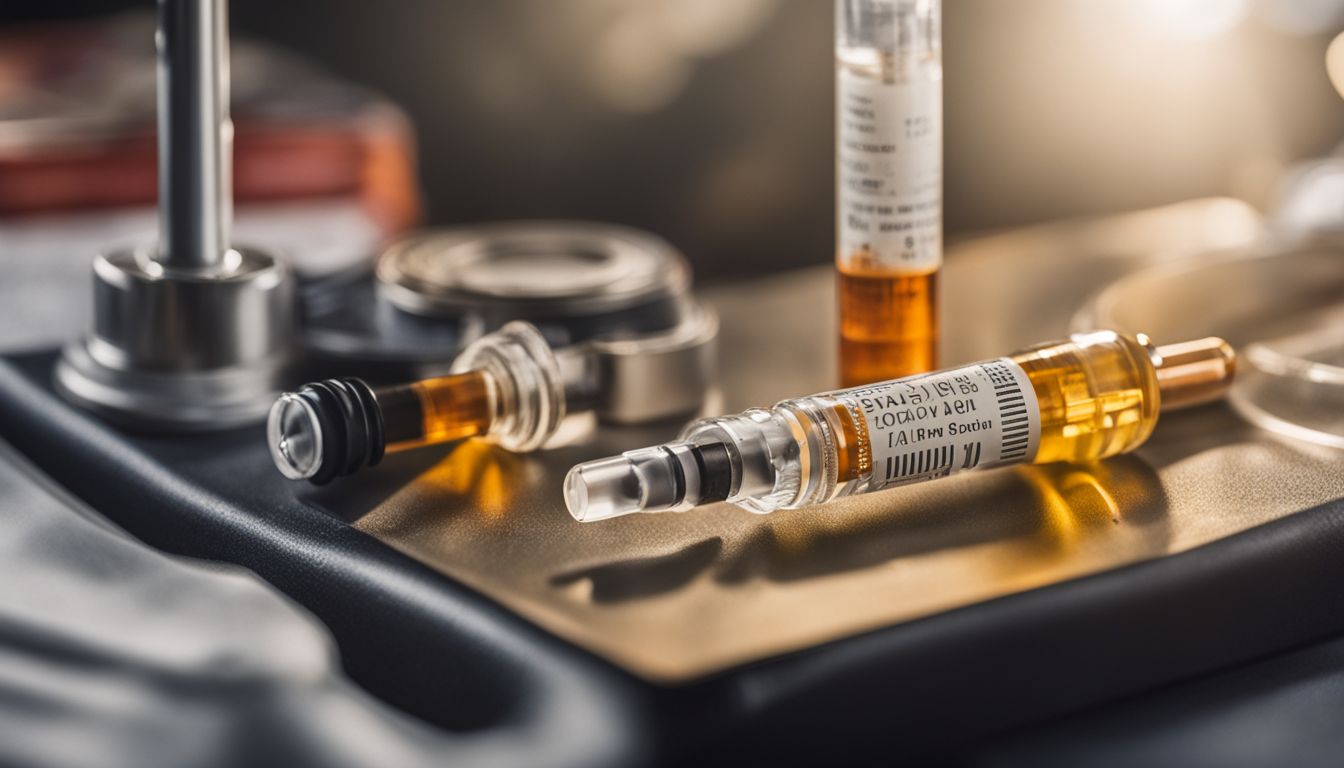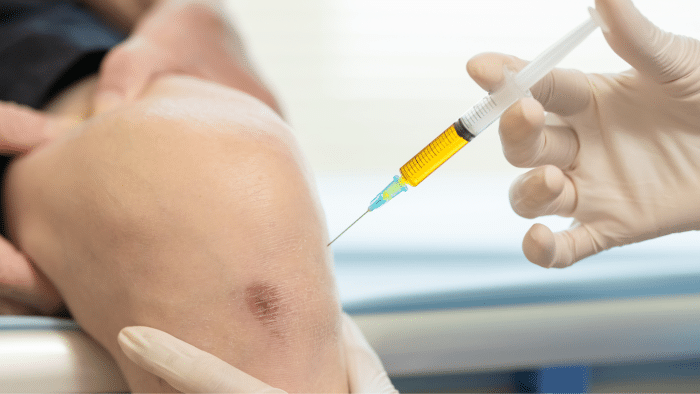
Knee pain affects millions worldwide, impacting their daily lives and mobility. Recent studies have highlighted the efficacy of knee injections in managing this discomfort. Among these treatments, Hyalgan, a viscosupplementation agent, is a promising solution for osteoarthritis-related knee pain.
Hyalgan, similar to the synovial fluid that naturally surrounds our joints, acts as both a lubricant and shock absorber. When osteoarthritis causes joint degeneration, this fluid diminishes, leading to pain and stiffness.
This article will delve deeper into the science behind Hyalgan, explore its benefits and potential side effects, and discuss its role in managing knee pain.
Key Takeaways
- Hyalgan knee injections are a viable treatment option for managing osteoarthritis, relieving pain, and improving joint mobility.
- Hyalgan’s composition, mechanism of action, and clinical efficacy make it a valuable choice for patients with knee osteoarthritis.
- Understanding patient selection criteria, injection techniques, and potential side effects is crucial for successfully administering Hyalgan knee injections.
About: Doctor Medica is your trusted supplier of top-quality dermal fillers, viscosupplements, and more for your medical practice. We offer genuine products from leading brands at the lowest prices. Contact Doctor Medica today if you want to buy Hyalgan for your practice.
What are Hyalgan Knee Injections?

Hyalgan is made up of a natural substance called hyaluronan. This critical component acts like the body’s own synovial fluid, making it an effective treatment for knee osteoarthritis. It serves as both a lubricant and shock absorber inside the knee joint.
Hyalgan knee injections help the knee move more smoothly. They do this by acting like a lubricant and shock absorber with insufficient natural synovial fluid. This fluid helps your knees bend with ease and cushions them.
Efficacy of Hyalgan Knee Injections

In exploring treatments for knee osteoarthritis (OA), Hyalgan knee injections present an interesting case study. They stand out among various options available to medical professionals. Let’s compare Hyalgan injections with other knee OA treatments in a structured manner.
| Treatment Option | Mode of Action | Efficacy | Duration of Effect | Side Effects |
| Hyalgan Injections | Intermediate molecular weight hyaluronic acid lubricates and cushions the joint | Comparable knee OA pain relief to other treatments | Up to 6 months | Local pain, swelling, rash |
| Synvisc Injections | Hyaluronic acid similar to Hyalgan but may vary in molecular weight and formulation | Temporary pain relief, similar to Hyalgan | Variable, generally a few months | Local pain, swelling, stiffness |
| NSAIDs (Oral) | Anti-inflammatory; reduces pain and swelling | Effective for pain management; does not stop OA progression | Short-term relief | Gastrointestinal issues, cardiovascular risks |
| Physical Therapy | Improves joint function through exercises and modalities | Varies; can be significant with consistent application | Long-term benefits with ongoing practice | Minimal potential for overexertion |
| Corticosteroid Injections | Anti-inflammatory: directly injected into the joint | Provides rapid pain relief | Typically, a few weeks to months | Risk of joint infection, increased blood sugar |
Clinical Applications of Hyalgan Knee Injections

Choosing suitable patients for Hyalgan injections is critical. This step ensures that those who receive it get the most benefit, especially in cases of knee osteoarthritis where pain does not improve with more superficial treatments.
Hyalgan knee injections help manage osteoarthritis by mimicking the body’s synovial fluid. For effective treatment, medical professionals must apply precise injection techniques and follow dosage recommendations.
- Assess the patient’s knee condition before administering Hyalgan. Removing extra fluid from the joint is sometimes necessary to ensure the medication can work effectively.
- A complete Hyalgan treatment involves five injections, given one week apart. Sticking to this schedule maximizes the patient’s viscosupplementation benefits.
- The Hyalgan dosage to be injected depends on the individual’s specific needs and how they respond to initial treatments. It’s vital to adjust as needed, but always within recommended guidelines.
- Performing intraarticular injections requires skill. Correctly positioning the needle ensures that Hyalgan reaches the joint area where it’s most needed, reducing joint inflammation and pain.
- After each injection, watch how the patient reacts to determine if adjustments are needed in subsequent sessions. This personalized approach helps improve overall efficacy in managing osteoarthritic knee pain.
- Know potential side effects and contraindications with Hyalgan injections. Always check a patient’s medical history for allergies or conditions that might increase risk during treatment.
- Explain what osteoarthritis management with Hyalgan involves, including expected outcomes and any possible discomfort post-injection. Knowledge empowers patients and helps manage expectations.
Most patients handle Hyalgan knee injections well, but some side effects can happen. These include pain at the injection site, stomach issues, headaches, bruising, a rash, itching feelings, numbness or tingling sensations, and back discomfort.
Conclusion
Hyalgan Knee Injections offer hope for those with knee osteoarthritis. These shots can ease pain and make moving around easier. A series of injections may provide relief for up to six months.
While there are some side effects, many find the benefits worth it. Hyalgan is a practical choice for managing knee osteoarthritis pain.
FAQs
1. What are Hyalgan knee injections for?
They help ease knee pain from arthritis.
2. Do the shots hurt a lot?
Some folks might feel a pinch, but it’s usually not too bad.
3. How long before I start feeling better?
Most people start to notice less pain in just a few weeks.
4. Will I need lots of these injections?
Depending on your doctor’s advice, you might get one shot a week for about five weeks.
5. Can anyone get these injections?
Your doctor will tell you if they’re right for you based on your health and knee condition.
References
Drugs.com. (n.d.). Hyalgan injection. Retrieved from https://www.drugs.com/mtm/hyalgan-injection.html
Huang, T. L., Chang, C. C., Lee, C. H., Chen, S. C., Lai, C. H., & Tsai, C. L. (2011). Intra-articular injections of sodium hyaluronate (Hyalgan®) in osteoarthritis of the knee. A randomized, controlled, double-blind, multicenter trial in the Asian population. BMC musculoskeletal disorders, 12, 221. https://doi.org/10.1186/1471-2474-12-221
Goldberg, V. M., & Goldberg, L. (2010). Intra-articular hyaluronans: the treatment of knee pain in osteoarthritis. Journal of pain research, 3, 51–56. https://doi.org/10.2147/jpr.s4733
Related Articles
Joanna Carr
Everything You Need To Know About Chemical Peels
Interested to learn more about Everything You Need To Know About Chemical Peels? Browse Doctor Medica's comprehensive listing of blog posts.
Joanna Carr
Dysport in Masseter: Applications and Considerations for Jawline Contouring
In this article, we explore the applications of Dysport in masseter for jawline contouring - its mechanisms, application techniques...
Joanna Carr
Financing Tips for New Medical Practice
Physician practice financing is always a hot topic in the medical industry. Find here the best options for starting your medical business.


